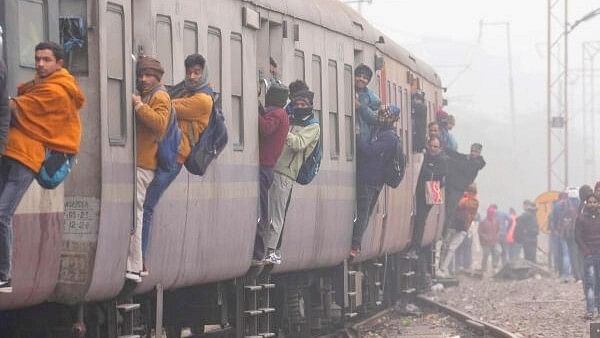
Cold and foggy winter morning, in New Delhi.
Credit: PTI Photo
New Delhi: A blinding layer of fog affected road and rail traffic in the north and eastern parts of the country on Thursday, officials said.
A spokesperson for the railways said that fog impacted the schedule of "24 trains approaching Delhi,"
The India Meteorological Department (IMD) reported “very dense” fog in isolated pockets of Punjab, west Uttar Pradesh, and Tripura; “dense” fog in parts of east Uttar Pradesh; Jammu, Haryana, Delhi, east Madhya Pradesh, Bihar, and Assam; and “moderate” fog in some pockets of north Rajasthan and west Madhya Pradesh.
Visibility levels dropped to zero metres in Punjab’s Bhatinda and Agra in Uttar Pradesh, 25 metres in Tripura’s Agartala, and 50 metres in Jammu, Hisar in Haryana, Varanasi, and Lucknow in Uttar Pradesh, Sagar and Satna in Madhya Pradesh, Purnea in Bihar, and Assam’s Tezpur.
The Palam Observatory, near the Indira Gandhi International Airport, reported a visibility level of 100 metres at 5:30 am. However, it improved to 500 metres by 7 am due to surface winds.
Rajasthan’s Ganganagar and Bhopal in west Madhya Pradesh recorded a visibility level of 200 metres.
According to the weather office, “very dense” fog is when visibility is between 0 and 50 metres, between 51 and 200 metres is “dense”, between 201 and 500 metres “moderate”, and between 501 and 1,000 metres “shallow”.
Parts of the northern plains recorded a lower maximum temperature compared to the hills on January 9 and 10.
According to Kuldeep Srivatava, the head of the IMD's regional forecasting centre, a layer of uplifted fog persisting over the plains since December 27 is preventing the sunshine from getting through.
"Therefore, maximum temperatures in some cases have been lower than the hills where the skies are clearer," he said.
The northern plains got some relief on Wednesday as the sun shone through the thinned layer of fog, but chilly winds kept the temperatures down.
“Cold day” to “severe cold day” conditions have been prevailing over many parts of north India since December 30-31.
A “cold day” is when the minimum temperature is less than or equal to 10 degrees Celsius and the maximum temperature is at least 4.5 notches below normal.
A “severe cold day” is when the maximum temperature is at least 6.5 notches below normal.